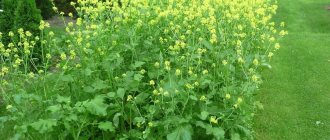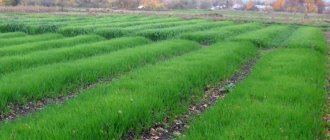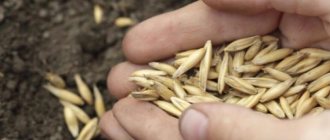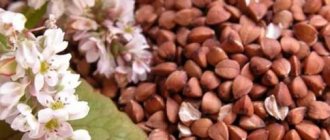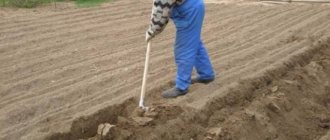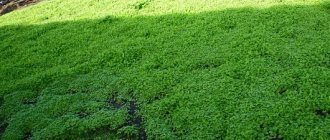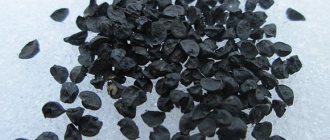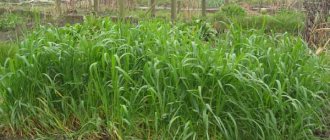When to dig up soil with mustard. Is it necessary to dig up mustard planted in the fall?
Before the end of the summer season, gardening lovers are concerned with the question of how to improve soil fertility and health? One of the interesting questions is: is it necessary to dig up mustard? Plants take nutrients from the soil, it becomes less fertile and depleted. Many summer residents use green manure to restore the soil.
The benefits of green manure
These are plants that, penetrating into the soil, provide it with minerals and organic substances. Phosphates, nitrogen, potassium. Green manure improves the soil structure. The most commonly used are legumes, lupine, rye, including mustard. The plant has a useful composition until flower stalks appear, then it loses its valuable substances.
Plowing plants into the ground is called green manure. The green mass is mowed, crushed, and dug into the soil where it grew. The root system, which is located in the soil, will rot, serve as fertilizer and give a long-lasting, positive result.
Mustard comes in Sarepta and white mustard. White mustard is used for fertilization. It is very effective for obtaining a good potato harvest. White mustard has a lot of advantages among green manures:
- Grows well, develops quickly at low atmospheric temperatures, can withstand frosts down to -3-5 degrees;
- Does not require special soil properties, grows quickly in any soil;
- Decomposes in the soil, has a most valuable effect, nourishing it and restoring its capabilities;
- Often used for mulching and protection from frost;
- Mustard prevents nitrogen from leaving the soil. Combining it with legumes increases the content of the element in the soil;
- Legumes perform the function of a getter, mustard functions as a nitrogen processor;
- Powerful roots make it possible to supply substances and microelements valuable for plants from the depths. The root system goes a meter deep;
- The highest nitrogen content is in the greens and roots of the plant. Digging makes it possible to transfer all useful microelements to subsequent crops. It has a stimulating effect on plant growth and formation.
Features of soil application
The local climate determines the sowing time for white mustard. I do this in the fall, and in August - September. Sowing is carried out in the cleared area where potatoes, cereals, and strawberries grew. Mustard has enough time to grow green. For example, on one hundred square meters of land, after harvesting, about 400 kg of plant fertilizer will grow.
The stems of young mustard should not be mowed when frost arrives; they will fall to the ground on their own. This way they will retain moisture and prevent them from freezing. With the onset of spring, the fates with mustard are dug up. In the fall, green manure is sown for spring germination; this procedure must be carried out on loosened soil. To protect against washing out during spring floods, deep embedding is carried out.
After sowing, sprouts appear on the fourth day. After 30 days they will reach 15 centimeters. To ensure good growth, it is necessary to water the plants. Small shoots are mowed down because they quickly harden and become a problem with shredding. At this time, the plant may lose its value due to the appearance of flower stalks. Once the seeds appear, mustard can multiply and become a nuisance weed that is difficult to remove.
The best time to dig up mustard is before flowering. Only at this moment is it full of nutrients that the soil needs so much for restoration and fertility. Using this method, the yield increases several times.
What green manure to sow before winter.
The most valuable crop among cereals is rye; it can be sown in the winter from August 25 to September 10. Before the onset of cold weather, the rye must establish a tillering node in order to continue development in the spring.
Rye is a very good green manure, but it is very allelopathic. That is, it completely displaces another culture. Even after mowing the rye, the roots remaining in the soil can suppress the growth and germination of seeds of other plants for up to 3 weeks. This must be remembered and the rye must be mowed 3 weeks before the expected date of planting garden plants.
Rye will rid your area of weeds, including wheatgrass. Wireworms really don't like rye.
Winter rye reliably covers the soil in the beds until spring, protecting it from weathering and drying out. Rye loosens the beds very well.
When to mow mustard. When to mow mustard
1-1.5 months after sowing, mustard grows to 15-20 cm, it is cut with a flat cutter or cultivator or mowed (as you like), after spilling it with a solution of EM preparations, which accelerates the fermentation processes and creates favorable microbiological conditions leading to enrichment soil nutrients and microelements.
I would like to draw your attention to the fact that the processes of decomposition of plant residues and humification take place only in the presence of moisture in the soil (and mustard is a moisture-loving crop, this was mentioned above), therefore, if you live in an arid region, then it is effective only with irrigation, but if In your region, droughts are periodic, so watering is required during droughts.
But look
Well, how do you like this green fertilizer and phytosanitary? Sow it - you won't regret it! If you have any difficulties purchasing seeds, then here you go.
High fertility and large harvests! See you later!
With all respect, Andrew!
Adding organic fertilizers to the soil has a beneficial effect on the future harvest. It has long been known that green manure is the simplest, most affordable and safest way to restore the soil. White mustard is a green manure that will not only prepare the soil for but also protect the area from some pests and microorganisms.
Why are green manures sown?
Green manures are specially planted crops that are sown in the off-season for their further incorporation into the soil. Such crops have a well-developed root system. Thanks to the roots, beneficial microelements and minerals rise from the lower layers of the soil to the upper ones, and the soil is thus enriched. Green manure has the greatest benefit: it converts hard-to-reach nutrients into easily digestible ones, and the roots and stems of white mustard provide powerful resistance to potato diseases such as scab, fusarium and late blight.
Experienced gardeners have long used this technology in crop rotation. It is not inferior in efficiency to the application of humus and manure and has a number of advantages:
- low cost;
- ease of planting and further processing;
- some crops crowd out weeds;
- most green manures rid the soil of pests;
- green manure quickly rots, improves its structure and enriches it with fiber and humus;
- the area does not become clogged or infected from the outside, compared to the application of manure.
An excellent green manure is mustard. Basic properties
The beneficial properties of this plant have made it a real boon for summer residents. Although many probably have a different idea about mustard. It is widely used in cooking and the food industry; it is a delicious savory snack, as well as a valuable honey plant. The collected honey tastes good, has a light color and a luxurious aroma. Mustard is also used in medicine. In addition, it turns out that mustard is a green manure that has many advantages over other crops.
How and when to plant white mustard
You can plant at any time at above-zero temperatures. Shoots appear in dry soil on the 4-5th day, in wet soil on the third. The seeds are scattered and then slightly buried with a rake, or sown in furrows and sprinkled with 2 cm of soil. No further care is required. Before flowering, the greens need to be mowed and embedded into the soil with a flat cutter. If green manure is sown in winter, that is, after harvesting potatoes, then it is left in the soil until spring.
Green manure plants help restore the fertility of the land and keep it in this condition for a long period. Various cereals and legumes are used as green manure. But still, gardeners and gardeners give greater preference to white mustard. This representative of the cruciferous family has numerous positive qualities.
- Unpretentious in care and maintenance.
- Gives high yields.
- Has early germination.
- Green mass contains a large amount of useful substances.
- It is a cold-resistant crop.
- Repels harmful insects.
- Capable of preventing the spread of most plant diseases.
When to mow mustard. Mow mustard correctly
How quickly the plant grows largely depends on watering and temperature conditions. Within a month, you will be able to notice a growth of 20 cm. However, if you plan to mow the sprouts, it is important to focus not on growth, but on flowering.
It is very important to mow before flowering occurs. There are at least three reasons for this:
- when flower stalks form, the stems and petioles near the leaves become coarser. As a result, the green mass is not processed so quickly in the soil. It is important that the leaves are tender, then they can quickly become green fertilizer.
- When the mustard begins to bloom, its nutrients, which the soil needs so much, are consumed. The function of green manure is lost. But if you mow it in time, then vegetables and berries will be able to receive the necessary nutrition;
- If mustard has formed seeds, then its reproduction occurs by self-seeding, which turns the necessary plant into an ordinary weed.
When you have already mowed the plant, you need to dig up the area thoroughly. Use a shovel, hoe and flat cutter as tools. In dry weather and rare rains, water the area in a timely manner. Only if the soil is moist will worms and other microorganisms “work” in it.
Vermicompost forms faster and the soil bears fruit better if you use certain additional preparations, for example Baikal EM-1. This product is pretty good. However, it is not suitable for poor, depleted soil. In addition, it does not work well without organic matter - humus and compost. How often does the soil need such humus? At least once every 4 years.
It is not always possible to improve the condition of the soil by sowing mustard. If the soil is sandy and clayey, then the formation of the humus layer is too slow. In this matter, the use of mustard for digging will not work. This option is suitable only when crops alternate and the land is already well developed.
What if you planted mustard, but it did not produce its seeds when growing? Then do not mow it, but leave it for the winter. With the help of a cultivator or a flat cutter in the spring, you can simply dig it up. So it can be used as mulch. However, this option is not as practical as using straw, sawdust and other materials.
Should I dig up green manure in the fall or not?
Alla_Cheholina RІСЃРµ R·Р°РїРёСЃРё R°РІС‚РѕСЂР°
Green manure can be sown both in spring and autumn. In the fall, it is more effective to sow green manure - “green manure” performs, among other things, the function of mulch for the winter, protecting the ground from freezing. Therefore, today the main topic of our article is about which green manure to sow in the fall, how to care for them and why do it at all. Green manure in autumn: cheap and effective
Now that the number of animals kept on farmsteads is becoming less and less common, and mineral fertilizers are not cheap and cannot replace adequate nutrition for the soil, more and more people are resorting to organic farming. The use of green manure in the fall is one of the main methods of organic farming.
What is the benefit of green manure sown in autumn?
• thanks to green manure, the winds will not dry out the soil; • melted snow and heavy rains will not be able to wash away nutrients from the soil thanks to green manure sown in the fall; • in addition to enriching the soil with humus and nitrogen, the well-developed root system of green manure planted in the fall rises from deeper layers to surface potassium and phosphorus; • some green manures can help get rid of nematodes, wireworms and other plant pests and diseases; • thanks to green manures planted in the fall, the yield of vegetables will increase by one and a half to two times, moreover, they have the ability to suppress the growth of weeds.
Phacelia When to sow green manure?
If we talk specifically about the autumn planting of green manure, then this should be done immediately after harvesting the main crop - that is, in August-September. Most often, mustard, phacelia, rapeseed, and vetch are used as green manure for autumn, and garden plots after the latest crops can be sown with oats and rye - this winter green manure will grow in the spring. How to sow green manure? It’s very simple: after harvesting and collecting plant residues, the land is cultivated with a cultivator or loosened using a flat cutter, and watered if necessary. Next, the seeds of the green manure selected for autumn are sown and covered with earth (up to 5 cm). As an option, simply scatter the seeds in a “fan” on the ground and cover them with mulch (preferably straw). We especially note that green manure, of course, is best sown as early as possible in August. After all, the warmer it is, the better green manure plants planted in autumn germinate, and the stronger their roots. And strong roots are not afraid of the first frosts. And the tops are not afraid of the first frosts: with the exception, perhaps, of heat-loving buckwheat, all green manure crops are cold-resistant.
Spring vetch If for some reason you missed the deadline for planting green manure in the fall or at the end of summer, but you really want to insulate and enrich your land in winter, remember: even 10 centimeters of seedlings is better than nothing. Of course, the help to the soil from such seedlings will be much less than if your mustard grew by 50-70 cm. And if the weather is dry, and the cold has suddenly set in, the seeds may not sprout at all, but may lie there until spring. Then maybe it’s better to wait until spring with green manure? Should I just mulch my garden for the winter? The choice is yours.
Do I need to mow or seal green manure planted in autumn?
The issue is painful and controversial; there are pros and cons in both cases. But let's think: in meadows and fields, where everything is constantly blooming and turning green, does anyone mow the grass and then plow it in for the winter? Of course not. So, maybe we can listen to Mother Nature after all?
Mustard as a fertilizer when digging. White mustard - like green manure when to sow
White mustard (Sinapis alba) is grown in almost all regions of Russia. Only permafrost zones are not suitable for annual cruciferous plants. The plant is unpretentious in care. Mustard is used as a spice in cooking and in gardening as a green fertilizer (mustard green manure). Let's look at when to sow and dig green manure mustard, and recommendations for growing.
How to use mustard as green manure
Mustard is grown from seeds. The seed size is 1-1.5 mm; it is convenient to place them one at a time in prepared grooves during the planting process. The plant will grow up to 70 cm in height. The leaf blades are pinnate, the plant blooms well. After the flowering period, pods with yellow seeds inside are formed (up to 15 pieces per pod). The flowers are bisexual, pollination occurs with the help of wind and bees.
Green manure
Mustard is sown to fertilize the soil. The plant enriches the earth with phosphorus and nitrogen. When digging up the area along with the growing mustard, it is immediately buried in the ground. Stems and leaves give their beneficial microelements to plants growing in the beds.
Using mustard as green manure is very convenient and effective. Green fertilizing does not require much effort from gardeners: the fertilizer does not need to be transported, it is enough to simply incorporate it into the soil. To do this, use a hoe, hoe or shovel.
The crop can be sown as fertilizer in the spring before planting garden crops on the site or in the fall after harvesting. The plant can withstand frosts down to minus 5 degrees. If you plant seeds in April, you can have time to nourish the soil before planting your garden plants.
What are the benefits of mustard for the soil?
Mustard blossom
Mustard is valued as a highly digestible fertilizer. It germinates quickly and grows a large green mass (up to 400 kg per 1 hectare).
The leaves and stems of the plant contain:
- Organic matter;
- Nitrogen;
- Phosphorus;
- Potassium.
Burying green manure
Benefits of green manure:
- Enriches the soil with useful microelements (phosphorus, potassium, nitrogen), the fertile layer improves;
- Green fertilizer is effective in restoring depleted soil. In 30-45 days it releases organic substances and microelements that are absorbed in the soil;
- It is able to absorb poorly soluble forms of mineral trace elements, making them easily accessible;
- Plays a role in improving soil structure and is used as a loosening agent in heavy soils. It performs the function of drainage, increases the breathability of the soil, a three-meter tap root penetrates the ground and ventilates it;
- Prevents the leaching of useful substances during watering or rain. Garden culture protects the land from wind and water erosion;
- The plant secretes substances that prevent the growth of mold, is capable of killing pathogenic bacteria, and reduces the content of putrefactive microorganisms and scab in the soil;
- Green manure is used as a mulching layer;
- The place where the spicy plant grows is protected from attacks by pests (wireworms, slugs);
- During the flowering period it is an excellent honey plant.
How to plant mustard on the plot
Beets for seedlings - when to sow
The size of the seeds allows gardeners to easily plant the plant in the garden bed, taking into account all the recommendations. The gardener determines the time for planting independently. White mustard will be beneficial for the soil when planted in spring and autumn.
Seeds for planting
Instructions on how to sow mustard in spring:
- When choosing a place for planting, it is important to take into account the predecessors and future neighbors of the plant. It is not recommended to plant white mustard if cruciferous plants have previously grown in the garden bed. The site should be sunny, protected from the wind;
- Dig up the bed, remove the roots of the weeds, water the soil with cool water;
- Make small furrows in the garden bed. The distance between the rows is at least 20 cm. Plant each seed every 10-15 cm, to a depth of 1.5 cm;
- Seed consumption – about 4-5 g will be needed per 1 m²;
- Sprinkle the grooves with earth (no more than 1 cm);
- Water the area generously from a watering can. Do not water through a bucket or hose. A strong stream of water can greatly bury or wash away the seeds.
Abundant watering from a watering can
The first shoots begin to appear after 3-4 days. Usually the seeds hatch at the same time, and the sprouts grow like a green carpet.
On a note. When the question arises of how best to sow white mustard manually in the spring to control weeds, you can use “scatter” planting. If you plan to sow a large area of the site, you can simply scatter the seeds on loose soil and bury them in the ground using a rake. In this case, the percentage of seedlings decreases and seed consumption increases.
What not to plant after mustard
We have already figured out what crop rotation is, why it is necessary, and what are the basic principles of crop rotation in the garden - see Crop rotation.
Let us remind you: It is harmful to plant all crops in the garden constantly in one place. The main rule: crops of the same family should not be planted in the same place earlier than after 3-4 years.
Among vegetable and berry crops, there are plants that are grown in one place for several years in a row, and there are those that do not tolerate replanting in old beds for several years. Who needs to wait:
- Cabbage and other cruciferous vegetables (radishes, radishes, turnips) return to their original beds no earlier than after 2-3 years.
- Cucumbers - annually in a new place, returning after 3-4 years.
- Tomatoes - can be planted in the same place in greenhouses, but with mandatory soil preparation - when digging in the fall, add fluff lime (from 50 to 100 g per 1 sq. m.), otherwise the soil becomes too acidic and the tomato bushes get sick.
- Beets, chard, spinach return to the old beds only after three to four years.
- Onions - it is permissible to plant three years in a row in one bed, then select another place.
- Garlic - it is advisable not to grow it in one bed for more than two years (the likelihood of soil contamination with stem nematode increases). Return after two years.
- Carrots - in the same place no earlier than after 2-3 years, otherwise there will be a sharp decrease in yield or killer doses of fertilizers will be required.
- Eggplants are in the same place sooner than after 2-3 years.
- Legumes (peas, beans, soybeans) - it is unacceptable to grow in the old place for four to five years. If after legumes the beds are occupied by nightshades, you can return the peas to their original beds after three years.
- Strawberries (strawberries) - in the same place for no longer than four years, then the beds should be moved (see the table of predecessors), it is unacceptable to replace the raspberries. By the way, strawberries do not tolerate land vacated by asteraceae, for example, Jerusalem artichokes, plants of the ranunculaceae family - these crops make the soil unsuitable for strawberries and strawberries for three to four years. Do not plant strawberries (strawberries) after nightshades (peppers, tomatoes, potatoes) - these crops can suffer from a common disease - verticillium wilt, which is very dangerous for strawberries.
- Potatoes - it is advisable to grow them in the same place no earlier than after 2-3 years. This rule is difficult for a gardener to follow, since a large piece of the garden is usually allocated for a potato plot. But if you plant potatoes not in one continuous area, but in ridges, then you can annually move one bed at a time to another area.
Table of bad and good predecessors for the main fruits, berries and vegetables
Spicy herbs: tarragon, savory, basil, marjoram, coriander. Greens: leaf and head lettuce, green onions (feather).
Digging methods
The tops are dug up 2-3 weeks before planting the cultivated plants. The depth of the soil on soft soils is 12-15 cm, on dense soils - up to 6-8 cm. The mustard is pre-mowed and the soil is turned over with a shovel or hoe using the “clump rotation” method, during which the bushes are completely covered with earth. Before work, be sure to moisten the soil and remove all weeds. For several weeks before sowing the main crop, the green mass rots. As a result, the soil structure is restored and enriched with mineral and organic substances.
In order for the decomposition of greenery to occur effectively, it is necessary to periodically water the soil. If it is necessary to speed up the processing of biological waste, then before mowing the green manure is additionally treated with a special biological preparation (Baikal, etc.).
To combat wireworms, the soil is also dug up. Lumps of soil with green mass are turned 180 degrees so that the vegetative part of the plant remains underground. The irritating smell of rotting tops has a negative effect on the pest larvae.
